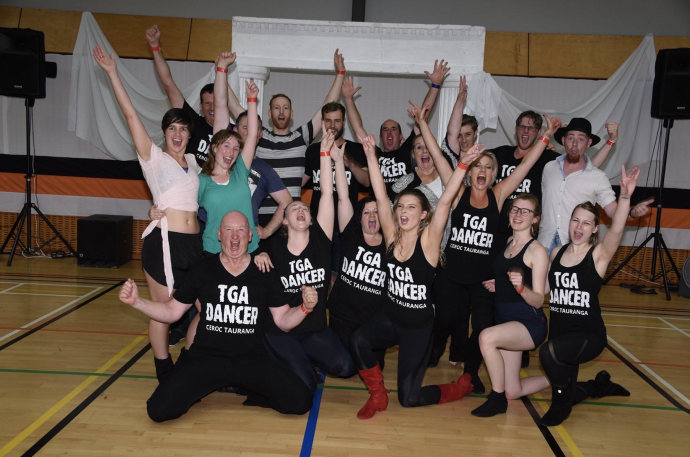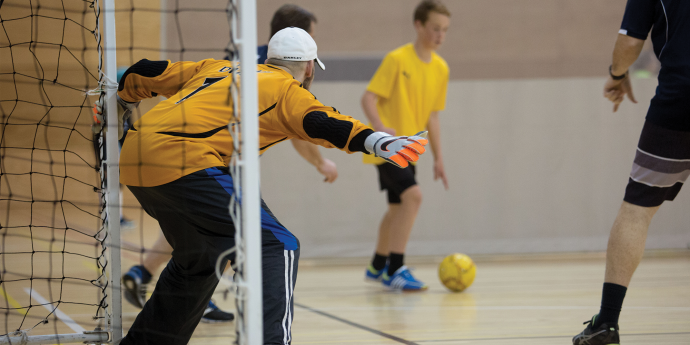The Game
Duration
The game is played in 8 minute quarters with 30sec change over between quarters. There is a 1min half time break.
Game Play
A toss up is taken at centre court between two centre players to start the game, if teams are not ready after 30 seconds the toss up will proceed. Toss up must be caught cleanly.
A player may defend another player with the ball but must be 0.9m (3 feet) from that player’s first grounded foot.
After a goal is scored a defence player must go to the top of the goal area and pass the ball off leaving one foot grounded as they release the ball. This pass must be touched before it goes over halfway. The attacks and centres of the opposing team must be 3 feet away from the passers first grounded foot. The other defence player can be anywhere in the defensive half.
INFRINGEMENTS
Obstruction
To defend a player with the ball you must be 3 feet (0.9 metres) away from the player’s first grounded foot.
By standing too close to a player with possession of the ball therefore obstructing their vision or ability to shoot the ball.
If a player steps back or to the side, you must still be 3 feet from the player’s first grounded foot.
A player will be penalized for obstructing an opposing player that is not in possession of the ball if they are within the 3 feet distance of that player and they employ any movements which take their arms away from their body. Within this distance a player is not obstructing if their arms are outstretched to:
Catch, deflect or intercept a pass or feint pass.
Obtain a rebound from an unsuccessful shot at goal.
Momentarily signal for a pass or to indicate their intended direction of movement.
Personal Contact
No player may come into contact with an opponent in order to interfere with the opponent’s play either accidentally or deliberately.
Professional Foul
Infringements taken at the umpire’s discretion, as a penalty pass or a shot at goal undefended.
A deliberate delay of play anytime during the duration of the game may result in the Umpire awarding the non-offending team with a five meter forward gain in court position and/or a penalty pass or shot.
Foot Foul
No deliberate kicking or stopping of the ball with any part of the leg/foot.
Blocking
A player may block 3 feet outside the goal area and in the goal area only provided their legs are no wider than the width of their shoulders and within 3 feet distance of the player the defending players hands remain by their side. No blocking through the court.
Contact with the Ball
A player in possession of the ball may not contact a player defending who is 3 feet away from his/her ungrounded foot.
All players who go out of their natural body stance i.e. straight up and down while defending or attacking the ball in play must not infringe the contact rule or obstruction rule.
Simultaneous Contact
If an umpire decides that two players have infringed simultaneously a toss-up will be held between those two players.
Stepping
A player in possession of the ball cannot slide or drag the grounded foot, hop onto the other foot or re-ground the landing foot before releasing the ball.
Out of Court
If the ball goes out of the court area, the opposing team must throw in the ball as close to where the ball went out. If a foot is placed on the line while throwing in the ball, the other team is awarded the throw in. Players do not have to wait for the umpire’s whistle.
Offside
If a player enters an area of the court they are not allowed in, a free pass will be given to the opposition.
Your foot on the line is offside.
Players can’t go offside to retrieve a ball at any time.
Replayed Ball
A player who has had control of the ball; stopped it, bounced it forward intentionally, had possession in the palm of the hand and caught it cleanly may not re-gather it unless it is touched by another player.
When having an attempt at goal the ball must touch the goal ring (not net or post) before the ball can be caught by the same player again.
Guarding
A player may not protect the ball with any part of their body in order to prevent the opposition gaining possession, whether it is intentional or unintentional. A free pass will be awarded to the non-opposing team.
Short Pass
A short pass between two players occurs when there is insufficient room for another player to come through/between the hands of the receiver and the passer.
Held Ball
A player who has either caught or held the ball must pass or shoot for a goal within three seconds of having received it.
Striking the Ball
Played on the Ground
The ball cannot be passed from a player lying, kneeling or sitting on the ground.
Umpires
The Umpire(s) shall have sole control of the game.
The decision of the Umpire shall be final and shall be given without appeal.
The ball shall be played live if it comes into contact with an Umpire during play, but if such contact interferes with the course of the game, the Umpire may decide to have a toss ball between two opposing players in that area of play.
The Umpires whistle shall:
Start and re-start the game at the beginning of each quarter and end each period of play.
Indicate when a goal has been scored.
Indicate when an infringement of the rules has been made.
The Umpire shall:
Refrain from penalizing an infringement of the rules when by doing so the non-offending team would be placed, at a disadvantage. In this instance the Umpire may call ‘ADVANTAGE’ or use hand signals to indicate an infringement has been observed but not penalized. Having blown the whistle for an infringement, the Umpire must award the penalty.
Not criticize or coach any team while a game is in progress.
State the infringement and penalty and may use hand signals to clarify decisions.
Answer questions regarding clarification of rules from team Captains only and only at quarter breaks or at the conclusion of the game.
Advise each team of the correct score at each quarter break.
Adjudicate the rules contained in this book both consistently and without bias.
Pass Off
A pass off from within the restart area shall be taken by a defense player to restart play after every goal has been scored.
The player taking the pass off must:
Keep one foot grounded within the pass off area until the ball is released.
Throw the ball within 3 seconds from taking their position within the pass off area.
Apply the footwork, replay and held ball rules from the moment of taking the grounded position within the pass off area.
At the time of the pass off all opposing players must be 0.9m from player’s grounded foot.
Penalties
A penalty pass or shot will be awarded when the following infringements occur (players must be beside and away from the player in possession of the ball);
Obstruction
Personal contact
Blocking a player through court
Blocking a player within 0.9m of the circle with legs wider than the shoulders and arms away from their side
Contact with the ball or on the ball
Interfering with the goal post
Guarding the ball
Free Pass
A free pass will be awarded when the following infringements occur (players do not have to stand down when a free pass is given);
Toss Up
Players will stand 0.9 meters apart, upright with arms down by your sides. The umpire will toss the ball and blow the whistle. Only when the whistle blows can the players move. An attempt to catch the ball must be made. A player must not bat the ball nor move their hands before the whistle is blown. If this happens a pass is awarded to the other team.
Interceptions
Interceptions must be taken cleanly.
Landing Space
Players in possession of the ball must be given landing space by players from the opposition.
Players without the ball cannot move into a person’s landing space causing inevitable contact.
A penalty pass or shot is awarded in these situations
Goal Tending
When a player is shooting for goal, defending players cannot hit the ball on its downward motion. When a defending player strikes any part of the goal hoop (including net). This is goal tending, and the goal will count.
Unsportsmanlike Play
Calling to an opposition player to pass the ball is not permitted and initially a free pass will be awarded. If a player continues to call for the ball they may be asked to leave the court.
Players may not call out or distract a shooter. This will be classed as intimidation and a penalty pass will be awarded. If a player continues to intimidate a shooter he may be asked to leave the court.
Nails and Jewelry
Medical alert bracelets may be worn but must be fully concealed by tape.
All watches, power bands and bracelets must be removed.
All jewellery, earrings and facial piercings must be removed.
Food and Drink
Consumption of foodstuffs and drink on court is not permitted (only water).
Blood Bin
Any players with bleeding wounds must leave the court. At the time the player is blood binned, the Umpire will ensure any equipment that is blood marked is replaced IMMEDIATELY and let play continue. A substitute can ONLY take up the vacant position. If no substitution is made, the injured player may return to the court only after the Umpire has been notified and a goal has been scored. Up to two minutes blood bin time can be taken.
Competition Scoring
5 Points for a win
3 Points for a draw
1 Point for a loss
-4 points if a game is defaulted
In the event of a draw in the finals, the team who won the round robin game will win.
Should this be a draw the team with the highest score in the round robin will win the game.




